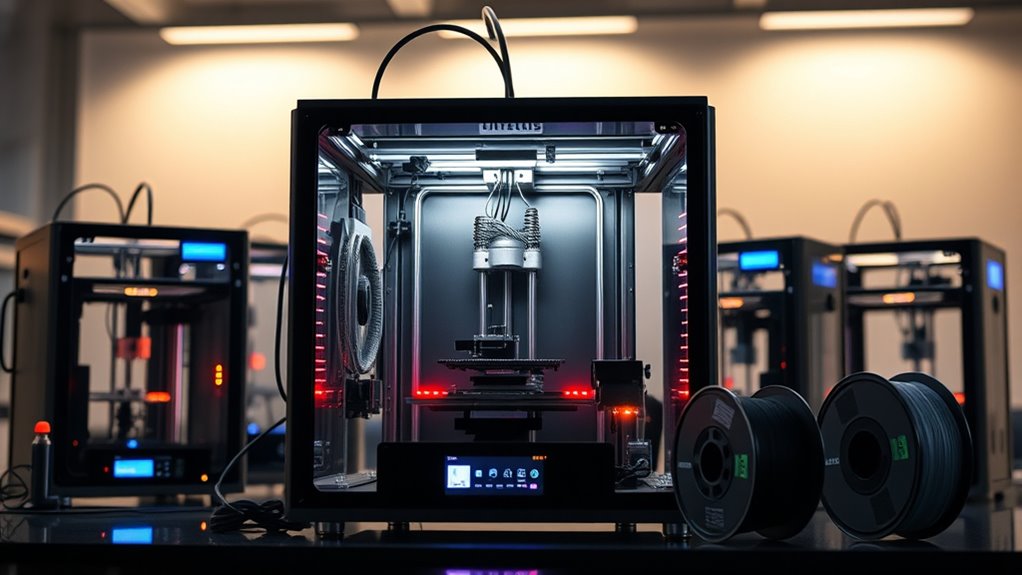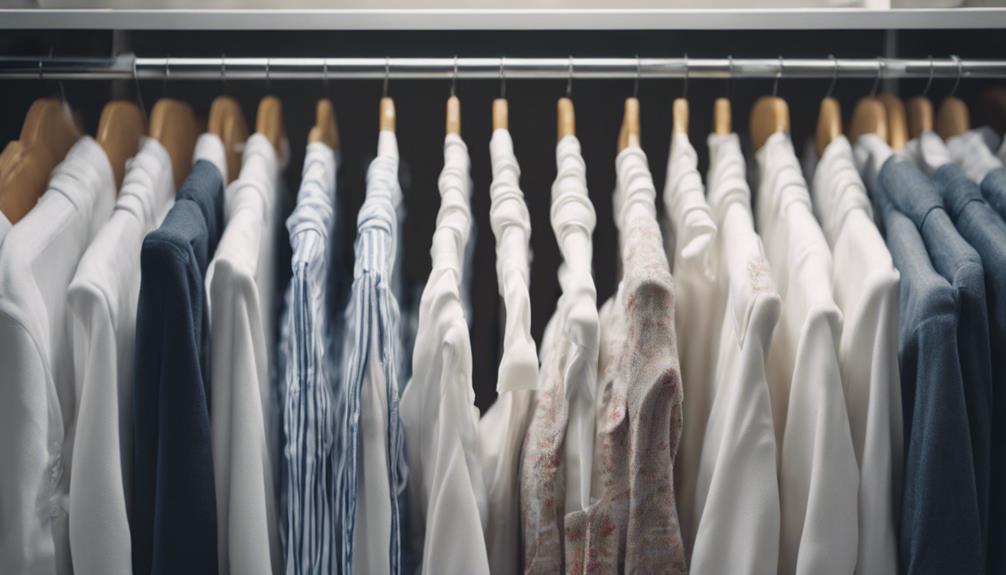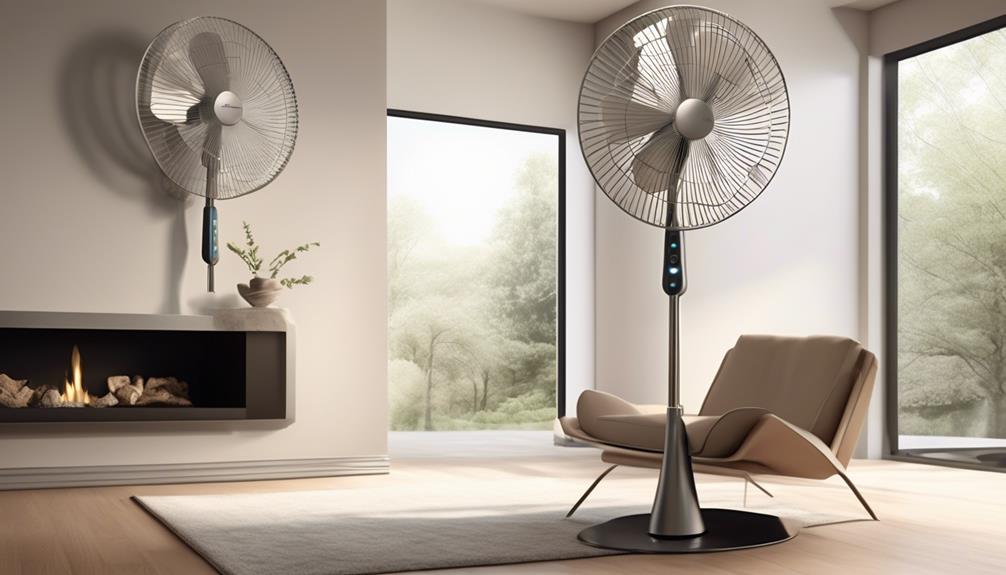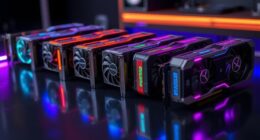If you’re looking for the 15 best auto‑leveling 3D printers of 2025, I’ve got you covered. These models combine fast speeds, precise auto‑bed leveling, and versatile features like multi‑color support and durable all‑metal structures. From beginner-friendly options to professional-grade machines, they promise reliable results and ease of use. Curious to see which ones stand out and how they can fit your needs? Keep going to uncover all the key details.
Key Takeaways
- The top printers offer advanced auto-leveling sensors like CR Touch and multi-point probes for precise bed calibration.
- High-speed models support printing up to 600mm/s with quick warm-up and stable CoreXY structures.
- Many units feature user-friendly interfaces, automatic calibration, and compatibility with diverse filament types.
- Compact designs with large build volumes and multi-material support cater to both hobbyists and professionals.
- Enhanced features such as AI cameras, silent operation, and active filtration improve usability and print quality.
FLASHFORGE AD5X 3D Printer, Multi-Color, CoreXY, Auto Leveling
If you’re looking for a versatile 3D printer that excels in multi-color, rapid prototyping, the FlashForge AD5X is an excellent choice. It supports up to four colors simultaneously, producing vibrant, detailed prints at speeds up to 600mm/s thanks to its CoreXY structure. The auto-leveling feature guarantees a smooth bed surface, improving print quality and reducing setup time. Equipped with a 300°C direct drive extruder and interchangeable nozzles, it handles various filaments like PLA, PETG, ABS, and TPU. Ideal for batch production and detailed models, the AD5X combines speed, precision, and user-friendly features for both beginners and experienced users.
Best For: hobbyists, educators, and small-scale manufacturers seeking fast, multi-color 3D printing with high detail and ease of use.
Pros:
- Supports up to 4 colors simultaneously for vibrant multi-color prints
- Fast printing speeds up to 600mm/s with CoreXY stability
- Automated bed leveling and user-friendly interface simplify setup and operation
Cons:
- Proprietary file format (.gx) complicates compatibility with standard slicers
- Software bugs and crashes, especially on MacOS, may require troubleshooting
- Wi-Fi connectivity is outdated and can be inconvenient due to re-establishing IP addresses
FLASHFORGE AD5M 3D Printer
The FLASHFORGE AD5M 3D Printer stands out for its rapid print speeds and user-friendly features, making it an excellent choice for professionals and hobbyists who need quick, reliable results. Its Core XY structure allows speeds up to 600mm/s and high acceleration, ensuring efficient, precise prints. The fully automatic one-click auto-leveling eliminates manual calibration, guaranteeing perfect first layers. Supporting multiple nozzle sizes and a dual-sided PEI platform, it offers versatility for various materials like PLA, PETG, and TPU. With a 220x220x220mm build volume, quick nozzle swaps, and a warm-up time of around 35 seconds, it’s designed for performance and ease of use.
Best For: hobbyists and professionals seeking high-speed, reliable 3D printing with minimal calibration effort and versatile material support.
Pros:
- Rapid print speeds up to 600mm/s with high acceleration for efficient production
- Fully automatic one-click auto-leveling ensures consistent first layers and ease of setup
- Supports multiple nozzle sizes and materials, including PLA, PETG, and TPU, for versatile printing needs
Cons:
- Occasional filament jams and extruder issues may require troubleshooting or part replacement
- Limited multi-color printing capabilities and some connectivity or software stability issues
- Open design can lead to less controlled environments and potential filament or adhesion challenges
ELEGOO Neptune 3 Pro FDM 3D Printer with Auto Bed Leveling
Designed for budget-conscious beginners and hobbyists, the ELEGOO Neptune 3 Pro stands out with its auto bed leveling system that guarantees reliable first layers. Its high-precision sensor scans 36 points, ensuring accurate Z-axis adjustments and smooth prints. The large build volume of 8.85×8.85×11 inches offers versatility for various projects. The dual lead screws and stable Z-axis drive provide precise, quiet movement, while the removable, magnetized metal bed simplifies removal and cooling. Compatible with multiple filaments like PLA, PETG, TPU, and ABS, it’s a reliable choice for those seeking quality results without breaking the bank.
Best For: hobbyists and beginners seeking an affordable, reliable 3D printer with high-quality print capabilities and easy setup.
Pros:
- Auto bed leveling with high-precision 36-point sensor for consistent first layers
- Large build volume of 8.85×8.85×11 inches suitable for various projects
- Quiet operation with stable, precise Z-axis movement and durable components
Cons:
- Manual may lack detailed setup instructions for bed magnetization and removal
- Occasional issues with nozzle clogging requiring maintenance or replacement
- Slightly larger footprint may require dedicated space for optimal use
FLASHFORGE Adventurer 5M 3D Printer with Auto Leveling
For hobbyists and beginners seeking a reliable, user-friendly 3D printer, the FLASHFORGE Adventurer 5M with auto leveling is an excellent choice. Its fully automatic bed leveling guarantees perfect first layers every time, minimizing manual adjustments. With a compact design, a 220x220x220mm build volume, and a rapid 35-second warm-up, it’s perfect for quick projects. The 280°C direct extruder with a detachable nozzle, Core XY structure, and dual PEI platforms deliver high precision and easy print removal. Support for remote monitoring, simple setup, and consistent performance make the Adventurer 5M a versatile, low-maintenance option for both hobbyists and beginners.
Best For: hobbyists and beginners seeking a reliable, easy-to-use 3D printer with high precision and minimal setup.
Pros:
- Fully automatic bed leveling ensures perfect first layers and easy operation
- Compact design with quick 35-second warm-up suitable for small projects
- Supports remote monitoring and is compatible with user-friendly slicing software
Cons:
- Limited build volume of 220x220x220mm may restrict larger projects
- Closed slicing environment could limit advanced customization for experienced users
- Some users report filament feeding issues or calibration challenges if not operated carefully
3D Printers Tina2 Basic 3D Printer for Beginners and Kids
If you’re new to 3D printing or searching for a safe, easy-to-use model for kids and beginners, Tina2 Basic stands out with its fully automatic bed leveling system. This compact, lightweight printer (just 3kg) is ready to use right out of the box, making setup effortless. It offers a 100x105x100mm build volume perfect for small projects and features a 2.4-inch LCD screen, Wiibuilder slicer, and offline printing via MicroSD card. Dual Z-axis rails ensure high precision, while the magnetic removable build plate simplifies model removal. Its intelligent auto-leveling system means no manual adjustments, making it ideal for educational settings, homes, and classrooms.
Best For: beginners, kids, and educational users seeking an easy-to-use, compact 3D printer for small projects and learning environments.
Pros:
- Fully automatic bed leveling system for effortless setup
- Compact, lightweight design ideal for home, classroom, or office use
- Supports offline printing via MicroSD card and features a user-friendly 2.4-inch LCD interface
Cons:
- Limited build volume (100x105x100mm) not suitable for larger models
- No heated bed, which may cause adhesion issues with some filaments
- Slightly noisy operation that might be noticeable in silent environments
Creality K1C 3D Printer
The Creality K1C 3D Printer stands out as an ideal choice for enthusiasts seeking high-speed, reliable printing with minimal setup effort. Its compact CoreXY design makes it lightweight and easy to handle, with setup taking just about 10 minutes—thanks to auto-leveling and bed mesh calibration. Built with solid materials, it supports fast printing speeds up to 600mm/s and handles a variety of filaments, including abrasive options like carbon fiber. Features like an AI camera for remote monitoring, silent operation, and an active carbon filter enhance user experience. Overall, the K1C delivers impressive quality, versatility, and speed in a user-friendly package.
Best For: hobbyists and professionals seeking high-speed, reliable 3D printing with easy setup, advanced features, and material versatility.
Pros:
- Supports high-speed printing up to 600mm/s with excellent part cooling and bridge performance
- Includes advanced features like AI camera, silent operation, and active carbon filtration for enhanced user experience
- Compact, lightweight CoreXY design with quick setup and auto-leveling calibration
Cons:
- Some users report minor issues such as small blisters on the print bed over time
- Filament tube arrangement could be improved for easier filament loading
- Initial setup or units may sometimes experience defects, emphasizing the importance of purchasing from official sources
FLASHFORGE Adventurer 5M 3D Printer with Auto Leveling and Large Print Size
The FLASHFORGE Adventurer 5M stands out as a top choice for beginners and hobbyists seeking a reliable, easy-to-use 3D printer with excellent auto-leveling capabilities. Its fully automatic bed leveling guarantees perfect first layers with minimal manual adjustment, saving time and reducing errors. The printer offers a generous print size of 220x220x220mm and can reach speeds up to 600mm/s, making it suitable for both quick prototypes and detailed projects. Its all-metal design, rapid heating, and support for multiple nozzle sizes make it versatile. Plus, remote monitoring via the Flash Maker app adds convenience, making it a solid, user-friendly option for new and casual users.
Best For: beginners and hobbyists seeking an easy-to-use, reliable 3D printer with excellent auto-leveling and fast setup.
Pros:
- Fully automatic bed leveling ensures perfect first layers with minimal manual effort
- Large print volume of 220x220x220mm suitable for diverse projects
- Supports high speeds up to 600mm/s for efficient printing and rapid prototyping
Cons:
- Limited to a closed slicing environment which may restrict advanced customization
- Some users experience filament feeding or nozzle clogging issues if not properly maintained
- Smaller print volume may be restrictive for larger or more complex projects
Creality K1C 3D Printer
For anyone seeking rapid, reliable 3D printing with minimal setup, the Creality K1C stands out. It boasts an impressive 600mm/s printing speed and 20,000mm/s² acceleration, making it over 12 times faster than most printers. The sizable build volume of 8.66×8.66×9.84 inches allows for large or multiple models at once. It’s pre-assembled, with auto calibration features like Z offset and leveling, so you can start printing in just about 3 minutes. Its advanced direct extruder supports various filaments, including carbon fiber, and the AI camera guarantees real-time monitoring, troubleshooting, and high-quality results every time.
Best For: hobbyists, educators, and professionals seeking rapid, high-quality 3D printing with minimal setup and reliable performance.
Pros:
- Exceptional printing speed of 600mm/s with high acceleration for faster production.
- Auto calibration features like Z offset and leveling simplify setup and ensure precise results.
- Supports a wide range of filaments, including high-temperature materials like carbon fiber, thanks to its advanced extruder and heatbreak.
Cons:
- Large build volume may require more space and handling.
- High-speed printing might demand more meticulous filament and temperature management.
- Advanced features and setup could be overwhelming for complete beginners without prior experience.
TINA2 Mini 3D Printer
If you’re new to 3D printing or want a compact, user-friendly machine, the HEPHI3D TINA2 Mini stands out thanks to its auto bed leveling with one-touch operation. It’s fully assembled, lightweight, and perfect for kids, students, or home use. It offers high-precision prints with dual Z- and Y-axis rails, ensuring stability and detail. The removable magnetic build plate simplifies model removal, and the 2.4″ LCD makes operation straightforward. Compatible with PLA, TPU, and PETG filaments, it comes with preloaded models and a sample filament, making it ready to use right out of the box.
Best For: beginners, kids, and home users seeking an easy-to-use, compact 3D printer for educational and hobby projects.
Pros:
- User-friendly with auto bed leveling and one-touch operation for easy setup and printing.
- Compact, lightweight design ideal for small spaces and home use.
- Compatible with multiple filaments like PLA, TPU, and PETG, offering versatile printing options.
Cons:
- Occasional filament jams and nozzle clogs reported by some users.
- Noise levels might be noticeable during operation.
- Durability concerns after several months of frequent use.
FLASHFORGE AD5M 3D Printer
Designed for both beginners and professionals, the FLASHFORGE AD5M stands out with its all-metal CoreXY structure, delivering high-speed, precise printing while maintaining excellent stability and durability. It features automatic bed leveling, ensuring perfect first layers and reducing setup time. The flexible double-sided PEI build plate supports various materials, including PETG, and its quick-release nozzle system allows fast swaps with multiple diameters. Capable of reaching speeds up to 600mm/s, it produces high-quality, reliable prints with minimal fuss. Its user-friendly touchscreen interface and remote monitoring make it easy to operate, making the AD5M a versatile, efficient choice for a wide range of users.
Best For: hobbyists, educators, and small-scale professionals seeking a reliable, high-speed 3D printer with automatic features and versatile material support.
Pros:
- All-metal CoreXY structure provides stability, durability, and high-speed precision up to 600mm/s
- Automatic bed leveling ensures perfect first layers and reduces setup time
- User-friendly touchscreen interface and remote monitoring enhance ease of operation
Cons:
- Noise from fans and mechanical components can be noticeable during operation
- Limited support for high-temperature materials like nylon due to hotend temperature restrictions
- Occasional print failures or hardware issues may occur, often related to user error or specific hardware limitations
Creality K1 SE 3D Printer
The Creality K1 SE 3D Printer stands out with its lightning-fast CoreXY system, making it an ideal choice for users who value speed without sacrificing quality. It reaches speeds up to 600mm/s and accelerates at 20,000mm/s², enabling rapid printing while maintaining precision. Its advanced direct extruder and tri-metal hotend handle flexible filaments like TPU and heat up in just 75 seconds. The sturdy aluminum frame ensures stability, and auto-calibration simplifies setup. With Creality OS, Wi-Fi connectivity, and open-source options, it offers a seamless user experience. Overall, the K1 SE delivers high performance, reliability, and ease of use for both beginners and seasoned enthusiasts.
Best For: users seeking a high-speed, reliable 3D printer that offers precise printing and easy setup for both hobbyists and professionals.
Pros:
- Achieves lightning-fast printing speeds up to 600mm/s with high acceleration for rapid project completion
- Features an advanced direct extruder and tri-metal hotend capable of handling flexible filaments like TPU and rapid heat-up times
- Built with a sturdy aluminum frame and auto-calibration for stability, ease of use, and consistent high-quality results
Cons:
- Some users have experienced hardware failures such as motherboard damage due to assembly issues
- Customer support from Creality has been reported as subpar by certain users
- The high-speed operation might require careful calibration to avoid surface artifacts and ringing
Creality K1C 3D Printer with Fast Printing Speed and Auto Leveling
For those seeking rapid production without sacrificing precision, the Creality K1C 3D Printer stands out with its lightning-fast 600mm/s printing speed and automatic leveling capabilities. It offers an impressive 8.66×8.66×9.84-inch build volume, perfect for large or multiple models in less time. Ready to use in about three minutes, it features auto Z offset, leveling, and input shaping tests, removing manual calibration hassles. Its clog-free direct extruder supports various filaments, including high-temperature materials like carbon fiber. Plus, the AI camera monitors prints in real-time, enhancing reliability, while advanced cooling improves print quality by reducing stringing and warping.
Best For: hobbyists and professionals needing rapid, high-precision 3D printing with minimal setup time and versatile material options.
Pros:
- Exceptional printing speed of 600mm/s with high acceleration for faster production.
- Automatic leveling and calibration simplify setup and ensure precise prints.
- Supports high-temperature filaments including carbon fiber, with an advanced extruder and real-time AI monitoring for improved reliability.
Cons:
- Large build volume may require substantial space for setup and operation.
- Advanced features and high-speed printing may increase the learning curve for beginners.
- The rapid printing speed might lead to increased noise levels during operation.
Creality CR Touch Auto Leveling Kit for 3D Printers
If you’re looking to automate bed leveling on compatible Creality 3D printers, the Creality CR Touch Auto Leveling Kit offers a reliable solution. Designed for models like Ender 3, Ender 5, and CR-10 with specific mainboards, it features multi-point detection to map the bed surface. Installation can be tricky due to vague instructions, but online tutorials help. Once set up, firmware updates are essential for smooth operation. The sensor ensures consistent first layers, improves adhesion, and reduces manual leveling time. While some users face firmware or hardware quirks, most report better print quality and reliability, making it a valuable upgrade for automating bed leveling.
Best For: hobbyists and experienced 3D printer users seeking to automate bed leveling for consistent first layers and improved print quality on compatible Creality models.
Pros:
- Automates bed leveling, saving time and effort during setup.
- Enhances print adhesion and surface finish through precise nozzle height adjustment.
- Long-lasting sensor with over 100,000 reuses, offering reliable performance.
Cons:
- Installation can be complex due to vague instructions and model-specific modifications.
- Firmware updates may cause crashes or revert to Chinese language, requiring troubleshooting.
- Compatibility issues may arise with certain mainboards or hardware setups, necessitating support or firmware alternatives.
Creality CR Touch Auto Bed Leveling Sensor Kit for 3D Printer
Anyone looking to improve print accuracy and reduce manual leveling efforts will find the Creality CR Touch Auto Bed Leveling Sensor Kit a valuable upgrade. It offers high precision through multi-point detection and is compatible with popular Creality models like Ender 3, Ender 5, and CR-10 with 32-bit mainboards. The durable, metal probe tip guarantees long-lasting performance, and installation is straightforward with proper guidance. Once set up, it provides consistent first layers, saves time, and minimizes manual adjustments. Although firmware compatibility can be tricky, many users successfully optimize their printers, making the CR Touch a reliable choice for better print quality.
Best For: 3D printer enthusiasts and users seeking to improve print accuracy and reduce manual bed leveling efforts with compatible Creality models.
Pros:
- High precision multi-point detection ensures consistent first layers and better print quality
- Durable metal probe tip offers long-lasting performance and shock resistance
- Easy installation with comprehensive tutorials, leading to time savings and improved user experience
Cons:
- Firmware compatibility issues may cause boot failures or display problems on some mainboards
- Firmware updates can be complex and may require technical skills or third-party support
- Limited accessories included, such as nozzles or detailed firmware files, may necessitate additional purchases
ELEGOO Mars 5 Resin 3D Printer with 4K Mono LCD
The ELEGOO Mars 5 Resin 3D Printer with 4K Mono LCD stands out for its high-detail printing capabilities, making it ideal for hobbyists and professionals who require precise, intricate models. It features a 4K mono LCD and COB light source, ensuring sharp, accurate results. With automatic, one-click leveling and a textured bed for better adhesion, it simplifies setup. Its tilting vat speeds up printing, while smart sensors prevent LCD damage. The large touchscreen, Wi-Fi support, and remote monitoring enhance usability. Overall, the Mars 5 offers a combination of high resolution, ease of use, and durability, making it a top choice for detailed resin printing in 2025.
Best For: hobbyists and professionals seeking high-detail, accurate resin prints with user-friendly features and reliable performance.
Pros:
- High-resolution 4K mono LCD with sharp, detailed prints.
- Automatic, one-click leveling and textured bed for easy setup and strong adhesion.
- Wi-Fi support and remote monitoring for convenient operation and time-lapse recording.
Cons:
- Non-hinged lid requiring removal when opened, which can be inconvenient in small spaces.
- Replacement parts like screens and FEP can be costly.
- Limited camera visibility for small models or obstructed views with larger prints.
Factors to Consider When Choosing Auto‑Leveling 3‑D Printers
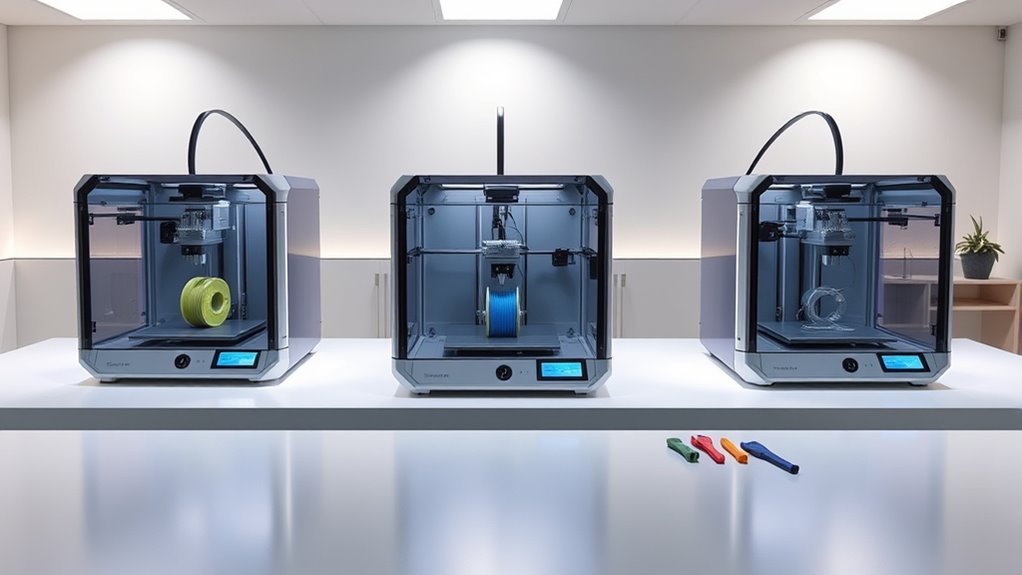
When selecting an auto‑leveling 3‑D printer, I focus on how well it automates leveling and how precise that process is. I also consider compatibility with various materials, speed, ease of calibration, and the support offered by its software and firmware. These factors help guarantee I choose a reliable printer that fits my project needs.
Leveling Automation Precision
Choosing an auto‑leveling 3‑D printer hinges on how accurately its sensor or probe can measure the bed height across multiple points. The key is higher point detection density—like 36 or more points—leading to more precise bed leveling and better first layer adhesion. The firmware and software’s ability to interpret sensor data also matters, as they determine the consistency and reliability of the leveling process. Mechanical factors, such as bed surface flatness and sensor mounting stability, influence overall accuracy. Even with advanced auto‑leveling, manual calibration might still be necessary periodically. However, a highly precise auto‑leveling system minimizes manual adjustments and ensures consistent print quality. When selecting a printer, prioritize sensors and algorithms that excel in measurement accuracy and data interpretation for superior results.
Compatibility With Materials
Selecting an auto‑leveling 3‑D printer requires guaranteeing that its system can handle the specific materials you plan to work with. Not all auto-leveling systems are optimized for every filament type, so check compatibility with materials like PLA, PETG, or ABS. Make sure the hotend and bed can reach the necessary temperatures—some high-temp filaments need up to 280°C. Also, verify that the auto-leveling sensor can accurately measure different bed surfaces, such as glass or textured plates, for better adhesion. Additionally, ensure the firmware and hardware support material-specific settings, especially for flexible or composite filaments, to avoid print failures. Finally, consider whether your chosen printer’s extruder can handle abrasive or specialty materials like carbon fiber or metal-infused filaments.
Speed and Efficiency
Speed and efficiency are crucial factors when evaluating auto‑leveling 3‑D printers, especially if you want to maximize productivity. Higher print speeds, like 600mm/s, allow for faster output but demand robust auto-leveling systems to maintain accuracy during rapid movements. Real-time mesh calibration features can substantially cut setup time and boost efficiency, especially for large or multiple prints. Consistent bed leveling ensures the first layer adheres properly, reducing failed prints and saving time and material. Efficient auto-leveling systems that integrate seamlessly with high-speed motion capabilities help guarantee quality isn’t compromised by speed. Additionally, the ability to quickly re-calibrate or auto-adjust during printing keeps operations smooth when switching materials or dealing with platform disturbances, making speed and efficiency essential for a hassle-free 3D printing experience.
Ease of Calibration
Ease of calibration plays a vital role in ensuring a smooth and efficient 3D printing process. Auto-leveling systems typically measure multiple points on the bed, with high-end models scanning 36 or more for better accuracy. This eliminates manual calibration, saving time—often less than five minutes. The precision of sensors like capacitive or inductive probes directly affects the consistency of the first layer and overall print quality. Proper sensor installation and firmware compatibility are essential for auto-leveling to work correctly and prevent calibration errors. Some printers perform auto calibration at the start of each print or periodically during longer jobs, maintaining ideal bed alignment. Overall, a system that’s easy to calibrate minimizes setup hassle and helps produce reliable, high-quality prints every time.
Software and Firmware Support
When choosing an auto-leveling 3D printer, it’s essential to take into account the quality and compatibility of its firmware. Reliable firmware supports automatic bed calibration and should be regularly updated to fix bugs and enhance performance. Compatibility with popular slicing software and the ability to generate compatible G-code are critical for smooth operation and consistent auto-leveling. Stable firmware with a user-friendly interface prevents crashes and guarantees reliable results every time. Support for firmware customization or community-developed updates can improve auto-leveling accuracy and enable advanced calibration features. Regular updates from manufacturers often include improvements for sensors, bed compensation, and overall print quality, making firmware support a key factor in selecting a long-term, dependable printer.
Build Volume Size
Choosing the right build volume size is a key step in selecting an auto‑leveling 3D printer. If you need to print large models or multiple parts at once, a bigger build volume is beneficial, boosting productivity and versatility. Conversely, smaller build volumes are ideal for detailed miniatures, prototypes, or educational projects, where space and material use are limited. The build volume directly affects the size of parts you can print in a single session, shaping your project scope. Keep in mind, larger build volumes often mean more complex, costly printers that require ample workspace. Auto-leveling features become even more critical with bigger beds, ensuring consistent first-layer adhesion across the entire surface, which is essential for successful prints.
Noise and Vibration Levels
Advanced auto‑leveling 3‑D printers often feature noise reduction technologies that make them much quieter than older models, typically operating around 45-50dB. This quieter operation results from high-quality, quiet stepper motors and optimized cooling fans that cut down on operational noise and vibrations. Enclosed or partially enclosed designs further dampen sound and vibrations, creating a more peaceful printing environment. However, high-speed printing at 600mm/s can increase vibrations, potentially affecting print quality unless the printer has effective vibration control features. Mechanical elements like rigid frames, dampening pads, and balanced cooling systems are key to minimizing vibrations that cause noise, ensuring smoother operation and better print results. Choosing a printer with these features can make your 3D printing experience more pleasant and efficient.
Maintenance and Durability
Durability and ease of maintenance are essential factors to contemplate when selecting an auto‑leveling 3‑D printer, as they directly impact long-term performance and reliability. Printers with sturdy sensors like the CR Touch or BLTouch support over 100,000 calibration cycles, ensuring longevity. The build quality of components such as the print bed surface and sensor mount influences maintenance needs and overall lifespan. Regular upkeep, like cleaning sensors and checking wiring, helps prevent issues. High-quality models often feature corrosion-resistant or sealed sensor housings, reducing dust and debris buildup. Additionally, robust frames made from aluminum or steel resist vibration and misalignment, minimizing recalibration and repairs. Prioritizing durability and straightforward maintenance can save time and money while ensuring consistent, high-quality prints over years of use.
Frequently Asked Questions
How Do Auto-Leveling Features Impact Print Quality and Reliability?
Auto-leveling features really improve print quality and reliability by ensuring the print bed is perfectly calibrated each time. I’ve noticed that with auto-leveling, my prints come out more precise, with fewer issues like warping or layer misalignment. It saves me time and effort, making the whole process smoother. Overall, auto-leveling boosts consistency, giving me confidence that my prints will turn out well every single time.
Are Auto-Leveling 3D Printers Suitable for High-Precision Industrial Applications?
Auto-leveling 3D printers are like the Swiss Army knives of the printing world, but when it comes to high-precision industrial applications, I’d say they’re more suited for prototyping than production. While advancements have improved accuracy considerably, they often still fall short of the ultra-tolerance standards needed for industrial-grade parts. For truly critical tasks, I recommend specialized machines designed specifically for industrial precision.
What Maintenance Is Required for Auto-Leveling Sensors Over Time?
When it comes to maintaining auto-leveling sensors, I find regular calibration is key. Over time, dust and debris can affect their accuracy, so I clean them gently with a soft cloth and check alignment periodically. I also update the firmware to guarantee peak performance. If I notice any inconsistencies during printing, I revisit calibration and sensor health to keep my printer running smoothly.
Can Auto-Leveling Systems Be Easily Upgraded on Existing 3D Printers?
Upgrading auto-leveling systems on existing 3D printers can be straightforward or tricky, depending on your model. I’ve found that many newer printers support plug-and-play upgrades, making installation simple. However, older models may require some modification or additional parts. I recommend checking compatibility first and reading user guides or forums. Overall, with a bit of research, upgrading auto-leveling sensors is often manageable and can markedly improve print quality.
How Do Auto-Leveling Sensors Perform With Different Filament Types?
When I first tested auto-leveling sensors with different filaments, it felt like tuning a guitar—each material needs a different touch. I found that sensors perform well with PLA, but with PETG or flexible filaments, calibration is trickier because they expand or contract differently. Overall, sensors are reliable but may need manual tweaks for certain filament types to guarantee perfect first layers every time.
Conclusion
Choosing the right auto-leveling 3D printer is like finding a trusty compass on your creative journey. With options from vibrant multi-color machines to precise resin printers, you’re equipped to turn ideas into reality with ease. Think of these printers as your loyal partners, smoothing out the bumps along the way. So, plunge in and pick the one that sparks your imagination—your next masterpiece is just a print away!

